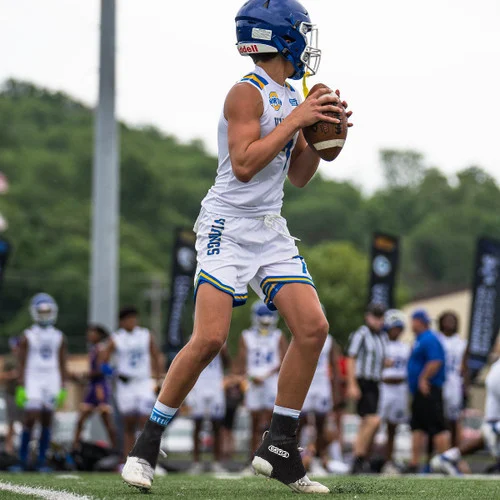First socks, then your shoes. This is the conventional wisdom most people follow when getting dressed in the morning. If you’re a football player, however, you may find yourself slipping an extra pair of sock-like spats around the outside of your cleats before heading out for a game. What’s the purpose of this compressive, cleat-covering cloth? Why do football players wear spats in the first place? Let’s slide into the world of football cleat sleeves, uncover their purpose, and explore how they can elevate your game—and your swag—when you’re on the gridiron. Football cleat spats, also known as cleat sleeves, are just that: sleeves that slide over your shoes and up your legs. They’re used to: Athletes use spats in a variety of sports—from baseball to soccer, basketball, competitive fighting, and beyond. Football spats, however, are unique to the gridiron and come in a variety of designs to suit the playing style of the game. When searching for spats to elevate your drip and enhance your performance on the field, you’ll notice there are three major kinds to choose from. The traditional trio of football spats includes: Whether you decide on low-cut, high-cut, or custom spats, they’ll all serve the same function once you slip them over your cleats and hit the field. Previously, football players applied multiple layers of athletic tape or turf tape to their shoes to support their ankles.1 These days, taping is often foregone in favor of cloth spats which offer more benefits to players. Spats offer superior ankle stability over standard cleats alone and other forms of ankle support as well. In fact, recent studies compared them to three other common ways of wearing cleats2: Spats were found to significantly decrease ankle movement in comparison to these other methods. But that doesn’t mean players couldn’t use their ankles to run, jump, and deke out the other team. Instead, reduced ankle movement lowers your chances of rolls, sprains, and other potentially sidelining injuries.2 Cleats are costly. The longer you can prolong their life spans, the more you'll have to spend on other football gear to max out your style. Spats give your cleats an added layer of protection in rough, dirty playing conditions. Unlike a shoe, which is difficult to clean and can be damaged by your washer, spats slip right off your cleats and can be laundered like normal clothing. This makes them the ultimate guard against mud, grass, dirt, and other debris that could muck up and damage your footwear. Quick movements on the field can lead to ankle rolling and twisting—which can, in turn, cause severe ankle sprains.3 Spats, however, reduce the possibility of injuring your ankles and enhance your on-field performance. With the added confidence and security of spats, you’ll be able to make quick cuts, split-second directional changes, leaps, and more to secure the ball and show off your swagger. Spats add extra padding to keep you warm during rainy running plays and ice-cold fourth quarters. Since they stretch under your cleats, they also offer added traction in comparison to standard studs alone. Similarly, the additional hold of spats can keep your cleats securely fastened to your feet when wet conditions cause everything (including your socks and shoes) to become slippery. Besides the practical and performance benefits of spats, players also wear them for football drip purposes. For fashion-forward footballers, spats offer: When jerseys, pant colors, and more are decided for you, you’re left with only a few ways to customize your look. Spats offer this freedom, so players have been using them for things like: When every player on your squad wears matching cleat sleeves, it creates a sense of comradery, oneness, and intimidation (for the opposing team). It also allows you to identify your teammates at a glance—even if you’re hunched down at the line waiting for the center to snap the pigskin. Spats are one of the only aspects of your jersey you have true control over. They’re your opportunity to express your character with custom colors, patterns, designs, logos, sayings, and more. In comparison to helmets, pads, pants, and other portions of your kit, they’re pretty much the only space for personalization. Spats keep your ankles secure and supported, your cleats fresh and clean, and your personality out on full display. At Battle Sports, we’ve got the football cleat sleeves you need to enhance your performance and your style—plus a locker room full of other essential equipment. From the stickiest football gloves in the game to the drippiest apparel you can wear streetside, our football gear is hotter than Travis Kelce’s 113-game streak with three or more receptions.4 Shop Battle Sports today to become the envy of your teammates and the scourge of your opponents. Sources:
Our PTFE coated fiberglass fabric combine the non stick and heat resistance of PTFE, with the strength and dimensional stability of fiberglass, creating a coated fabric suited for a variety of demanding civil and industrial applications.
The General Characteristics of PTFE coated kevlar fabric is:
PTFE Oven Sheet, PTFE Coated Fiberglass Fabric, PTFE Coated Fabric,Ptfe Coated Kevlar Fabric NINGBO TIANSHUO (SUPERBRIGHT) TECHNOLOGY CO. LTD. , https://www.ptfe-supplier.com
What Are Cleat Spats For?
Types of Cleat Spats
The Key Reasons Football Players Wear Spats
Ankle Protection and Injury Prevention
Improved Cleat Durability
Enhanced Stability and Performance
Weatherproofing and Field Conditions
Style and Aesthetic Benefits of Wearing Spats
Creating a Uniform Look
Making a Personal Style Statement
Explore Battle Sports Football Spats—and Other Accessories—Today

*Resistance to temperatures ranging between -55 and 260°C;
*Excellent non-stick properties;
*Excellent resistance to aggressive chemicals
*Low friction surface with excellent Release
*Food Approval
*Dimensional Stability under heat & pressure
*Low electrical losses
We produce a variety of PTFE coated fabric in
different PTFE content and finish type. And they meet a range of
application based on weight, thickness, surface finish, dielectric
properties, etc.
November 18, 2024